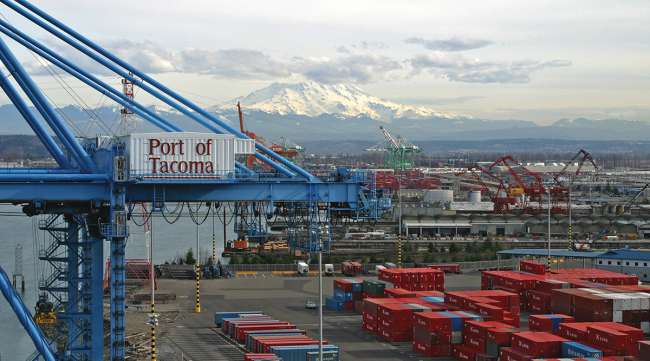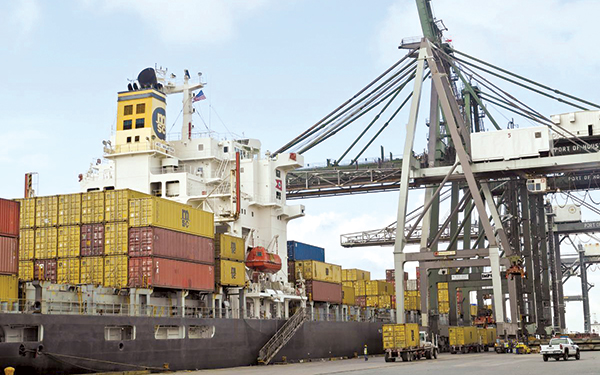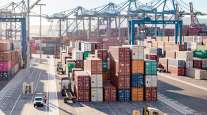Senior Reporter
Most Ports See Container Volumes Decline in January

[Stay on top of transportation news: Get TTNews in your inbox.]
Facing strong headwinds from the lingering effects of the U.S.-China trade war, the slowdown associated with the Chinese New Year, and later the coronavirus, most of the nation’s ports saw container volumes fall in January.
The Port of Los Angeles, the nation’s busiest, saw the number of 20-foot equivalent units fall 5.4% in January when compared with 2019. The port processed 806,144 TEUs compared with 852,449 a year ago.
“We anticipated that tariffs would continue to impact cargo volumes as we moved into 2020, and our January volumes reflect that ongoing trend,” Port of Los Angeles Executive Director Gene Seroka said.

Seroka
“The coronavirus, which prompted China’s central government to extend the Lunar New Year holiday, adds a new layer of uncertainty to global trade,” he added. “The Port of Los Angeles is committed to ongoing collaboration with our customers and supply chain partners to innovate and adapt to new trade patterns.”
The nearby Port of Long Beach, the nation’s second busiest, saw a 4.6% year-over-year drop in January. The port processed 626,829 TEUs compared with 657,286 in 2019.
“The new year is starting with a new set of challenges that are impacting importers and exporters, but we remain optimistic and expect to see modest growth in 2020,” Port of Long Beach Executive Director Mario Cordero said.
The downturn is not limited to the West Coast ports, which rely heavily on cargo to and from China. The nation’s third-busiest port, the Port of New York and New Jersey, saw its monthly container volume slip in January by 0.9%, to 617,024 TEUs compared with 622,531 during the year-ago period.
The Port of Oakland saw a dip of 0.6% in January, processing 211,160 TEUs compared with 212,433 in 2019. Port officials expressed concern the rest of the first quarter could produce lower numbers.
“Quarantines and other emergency measures have slowed Chinese manufacturing output, according to reports. As a result, shipping lines are canceling some springtime voyages to the U.S.,” a Port of Oakland statement said.

Bingham
IHS Markit Transportation Economist Paul Bingham told Transport Topics imports from Asian nations had slowed during January because of the Chinese New Year, but then came the coronavirus.
“We started to see a weakness at the end of the month, some of which predated the coronavirus issue,” he said. “There was already an underlying weakness, and I think some people had missed this in their focus on the coronavirus in production and supply chains.
“It’s not as if we had a very robust, strong trade pattern already there, and the coronavirus hit. We were already weak.”
The Northwest Seaport Alliance, which operates facilities in Seattle and Tacoma, Wash., saw a 19.1% year-over-year drop in TEUs as it processed 263,816 containers compared with a record 326,228 last January. The port authority said that last year, many shippers rushed to get imports into the U.S. ahead of the tariffs, and now it is concerned about the coronavirus.
“The NWSA also continues to monitor developments of the coronavirus outbreak and expects to see negative impacts to the international trade industry, including the Seattle and Tacoma gateway,” the port authority said in a statement.
On the East Coast, the Port of Savannah saw a 12.7% decline in January volume as the port processed 377,672 TEUs compared with 433,079 in 2019.
Even with the one-month dip, Georgia Ports Authority Executive Director Griff Lynch announced it had acquired 145 acres of land to expand, and construction was complete on another terminal that will allow for dockworkers to load and unload three 14,000-TEU vessels and up to eight vessels simultaneously.

Reinhart
The Port of Virginia saw a 5.3% decline in January, to 227,234 TEUs from 240,111 in 2019. While officials are cautiously optimistic about the trade picture improving, they are worried about the coronavirus.
“The agreement the federal government and China came to in mid-January will go a long way to restoring export volumes of agricultural products moving across the Port of Virginia,” CEO John Reinhart said. “We anticipate seeing a rebound in those cargos in February, March and beyond, but the concerns related to the coronavirus are creating some new uncertainty in the industry.”

The Port of Houston (above) was one of two major ports to post year-over-year increases for January. The other was South Carolina's Port of Charleston. (Port of Houston Authority)
Only two major ports, in Charleston, S.C., and Houston, saw January increases. The Port of Houston reported a 7% increase in TEU volume, processing 268,774 compared with 250,946 in the same month last year. The Port of Charleston saw a 2.6% year-over-year increase, processing a January record 211,020 TEUs compared with 205,689 in 2019.
Houston officials say their port’s reliance on plastic products fueled the increase. In South Carolina, officials say the region’s inland port network is seeing growth as more cargo is moved to and from the Port of Charleston via overnight rail.
Want more news? Listen to today's daily briefing:




